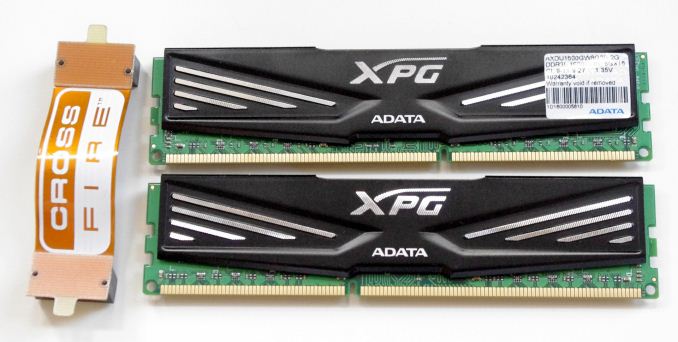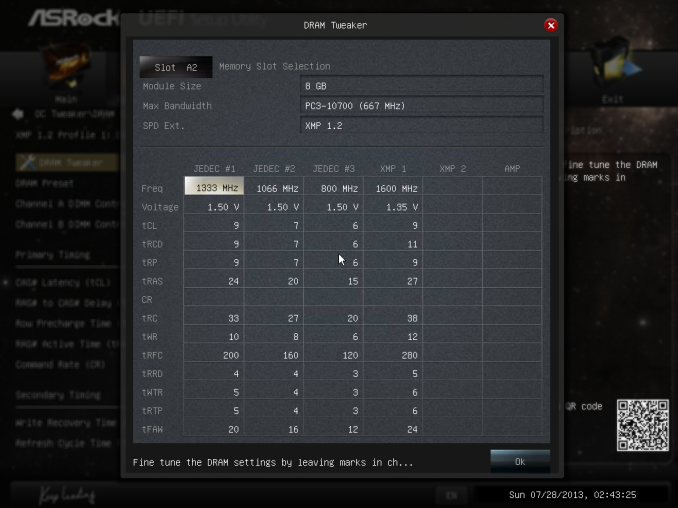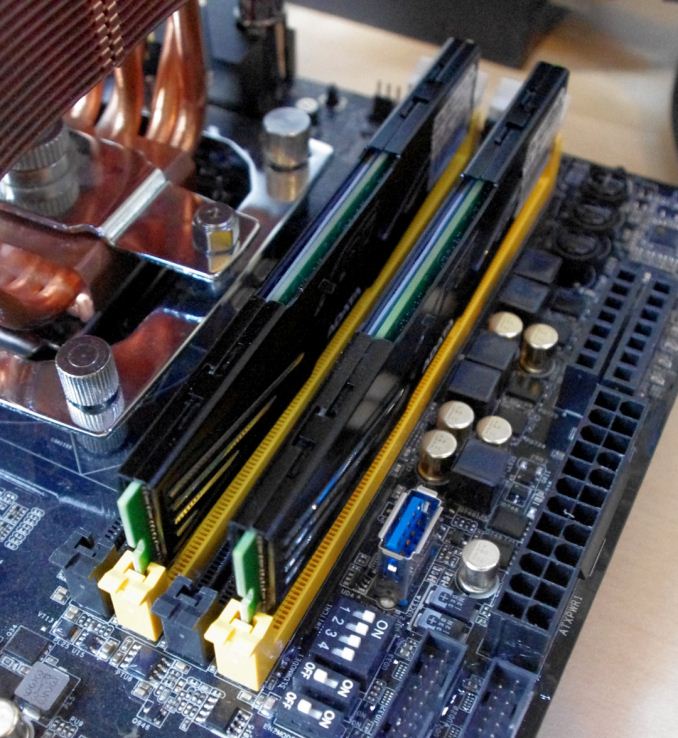ADATA XPG V1.0 Low Voltage Review: 2x8 GB at DDR3L-1600 9-11-9 1.35 V
by Ian Cutress on December 6, 2013 2:00 PM EST
For the next in our series of memory reviews on Haswell, we have another ADATA kit to test: this time a low voltage 2x8 GB kit featuring DDR3-1600 C9 timings. Being lower down the chain on a SKU list, the heatsinks are also smaller than the ones previously tested, and come in at £125. Previously in our big roundup of Haswell testing we suggested 1866 C9 being the minimum people should consider: would going 1600 C9 LV matter that much in results?
ADATA XPG V1.0 2x8GB DDR3L-1600 C9 1.35V Overview
ADATA’s line away from the more extreme (2400+) memory setups is aimed more conservative. If they were to use the same DRAM chips on board, those 2400 MHz C10 kits might hit lower voltages or lower CL numbers when we move down to 1600 MHz, so there is some potential in diversifying the product line of the same ICs as long as the market is there.
The AXDU1600GW8G9B-2G kit we are testing today is very unassuming next to those higher end modules – a simple small metallic based heatsink. When using a large air cooler like my TRUE Copper, they were easy enough to fit in unlike some of the larger modules.
The lower voltage element of memory intrigues me, most likely for the wrong reasons. The difference between 1.50 volt and 1.35 volt memory, in an overall system build, is not going to affect power draw in a measurable way. If you were building a 42U rack of servers, then yes, multiply out the DRAM modules you need across all the sockets and it can make sense if they are going to be active all the time. But at this juncture, even when a system draws sub 30W on idle and under 100W load, I cannot see a picture where moving from 1.50V to 1.35V makes a sizeable difference to a yearly electricity bill. Others may argue this point, but finding consistent data that converts to a decent power saving is hard to produce or come by. It would be more applicable to buy a lower TDP CPU (such as the i7-4765T, or E3-1230L V3) instead. That leaves a bit of e-peen for being low powered and green as positives, and the kit obviously has to stand on its own two feet when we push through the benchmarks.
In our big memory round-up for Z87 and Haswell, our cautionary tale was that slower MHz (under 1866) kits, rather than being restrictive, have a few holes in their performance on certain benchmarks, causing a 10-20% performance drop compared to the asymptotic limit hit when you go beyond 2133-2400 MHz. This ADATA 1600 C9 Low Voltage kit hits a couple of pot holes in that regard: WinRAR could be faster, as well as some of the minimum frame rates on a few games.
For Overclocking, our kit comes out of the bag with a Performance Index (PI) of 178: we pushed this to a PI of 200 (2000 10-12-10) with very little effort. This is a bit different from the PI of 240-260 which we see on the higher end kits.
Price wise, 2x8 GB 1600 C9 memory kits can be found for under $150 – the cheapest on Newegg today is actually a 1.35V kit for $129, followed by a 1.65V kit for $130. ADATA do not list this kit on Newegg, but in the UK the pricing is around £125 – if you take off our 20% tax and do the conversion, that lists it as nearer $170. ADATA’s XPG V2 and V1 normal voltage kits are at $165, with another at $150. This is still above some of their competition, and around $150 would make it a competitive choice for this segment.
Specifications
| ADATA | ADATA | Corsair | Patriot | ADATA | G.Skill | |
| Speed | 1600 | 2400 | 2400 | 2400 | 2800 | 3000 |
| ST | 9-11-9-27 | 11-13-13-35 | 10-12-12-31 | 10-12-12-31 | 12-14-14-36 | 12-14-14-35 |
|
Price (at review) |
£125 | $200 | - | $92 | $316 | $520 |
| XMP | Yes | Yes | Yes | Yes | Yes | Yes |
| Size | 2 x 8GB | 2 x 8GB | 2 x 8GB | 2 x 4GB | 2 x 8GB | 2 x 4GB |
|
Performance Index |
178 | 218 | 240 | 240 | 233 | 250 |
|
|
||||||
| MHz | 1600 | 2400 | 2400 | 2400 | 2800 | 3000 |
| Voltage | 1.35 V | 1.65 V | 1.65 V | 1.65 V | 1.65 V | 1.65 V |
| tCL | 9 | 11 | 10 | 10 | 12 | 12 |
| tRD | 11 | 13 | 12 | 12 | 14 | 14 |
| tRP | 9 | 13 | 12 | 12 | 14 | 14 |
| tRAS | 27 | 35 | 31 | 31 | 36 | 31 |
| tRC | 38 | 46 | 43 | 49 | ||
| tWR | 12 | 20 | 16 | 16 | ||
| tRRD | 280 | 315 | 301 | 391 | ||
| tRFC | 5 | 6 | 7 | 7 | ||
| tWTR | 6 | 10 | 10 | 12 | ||
| tRTP | 6 | 10 | 10 | 12 | ||
| tFAW | 24 | 33 | 26 | 29 | ||
| CR | - | 2 | 3 | 2 | ||
As you can imagine, this being our 1600 C9 kit for testing, the sub-timings are smaller than all the other kits we have tested. With a PI of 178 out of the box, there should hopefully be some room to grow.
Visual Inspection
Thankfully ADATA have avoided using annoying plastic packaging that can be a pain to get into – there is a simple tab on the back to help open their XPG line of memory. The packaging is simple enough, just a thin molded plastic to hold the memory in place. Out the memory modules come, barely taller than memory without heatsinks.
There is a slight z-height addition, but it should not affect many (if any) builds:



















35 Comments
View All Comments
MelvisLives - Friday, December 6, 2013 - link
even for things like folding the T/S series make little senseI run my normal 84W haswell i5 at 2.6Ghz with a -0.26V offset to allow me to run it in my htpc case without a cpu fan, maths says its max tdp will be about 40W, with the added bonus I can increase it if i want or move case.
so i guess my point is, T series cant be made to hit the same levels as a standard i5 but a standard i5 will undervolt/underclock to T series level, and they cost exactly the same, making T series poor value.
popej - Friday, December 6, 2013 - link
I have recently flashed BIOS update, which included new microcode from Intel. As I understand this microcode update not only disabled any overclock for non-K Haswell (multicore enhancement) but also possibility to undervolt CPU. It is quite possible, that your i5 could be affected too.MelvisLives - Saturday, December 7, 2013 - link
thats sad to hear if its true, and does change things slightly, but it also means that intel are aware how poor value the T/S chips are and are trying to keep a market for them since a i5-4570 is the same price as an i5-4570S and 4570T.peterfares - Sunday, December 8, 2013 - link
But that raises the question: why bother? If they're the same chips sold at the same price, why artificially make three different models with different capabilities? It makes sense if they sell them for different prices (even if it is a douchy thing to do).ShieTar - Tuesday, December 10, 2013 - link
The non-T/S versions are usually better/more efficient than specified, so in most cases they will indeed perform the same as the T/S. But you could be unlucky and get a unusually inefficient normal chip, which really uses up its 84W TDP.purerice - Friday, December 6, 2013 - link
Thank you for your explanation. I actually had been tempted by the 4770S/4670T because I thought there was a bigger difference. I am still in the age where underclocking was done manually.As for this RAM, the article was very in depth and well-done but I am a little disappointed that the article didn't show any make or break situations. For example, all of the dGPU framerates were playable while none of the iGPU framerates were playable. The tests should have been done at resolutions that would have produced borderline playability to better see in which situations the there would be a noticeable difference.
MrSpadge - Sunday, December 8, 2013 - link
Agreed: regular CPUs with lowered voltage are far better value than S/T models. Or underclocked and undervolted, if necessary. This does involve manual testing, though.oranos - Friday, December 6, 2013 - link
what's the point of "low voltage" ram. I fail to see any real world difference between 1.35v and 1.5v standard.MrSpadge - Sunday, December 8, 2013 - link
You've got to run a lot of them, like in a server farm, for this to matter.shing3232 - Friday, December 6, 2013 - link
I would like to have this kind of ram at laptop